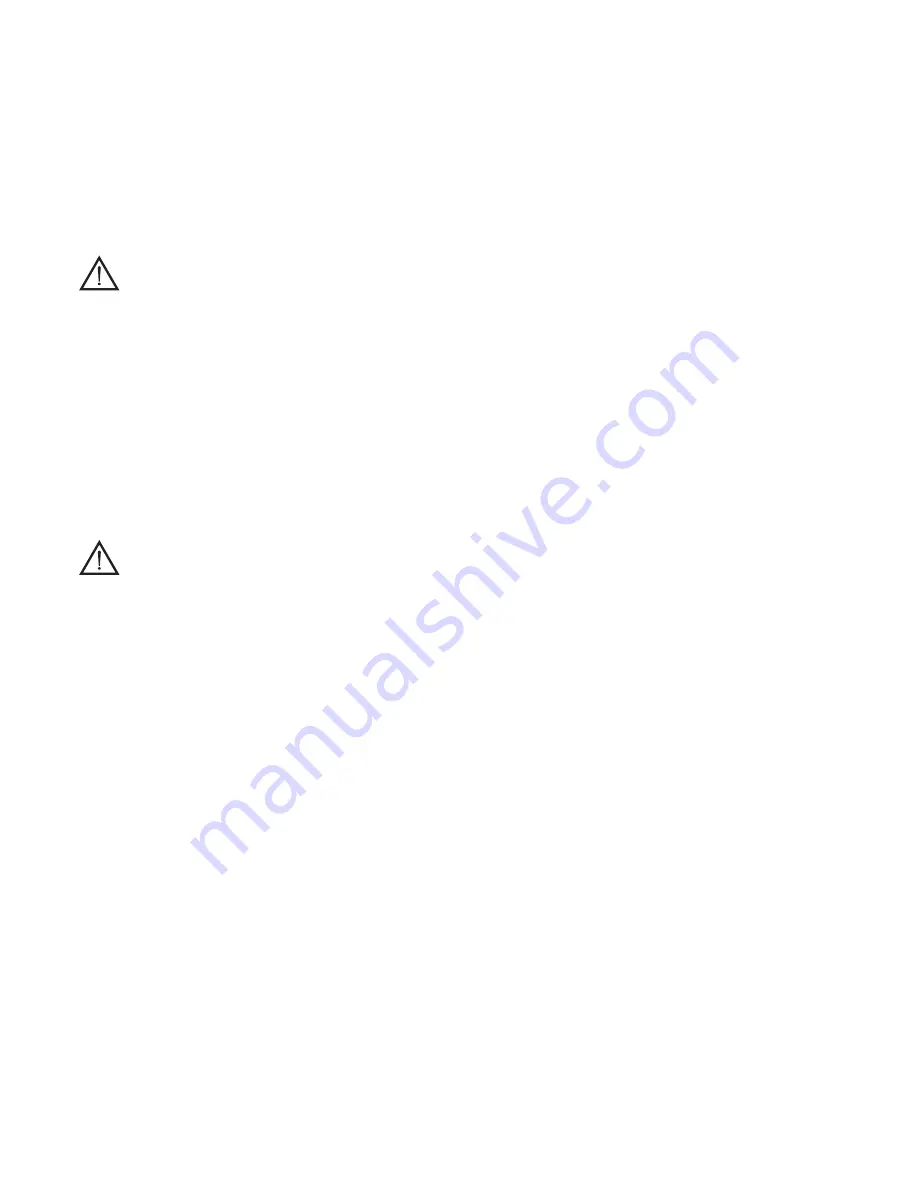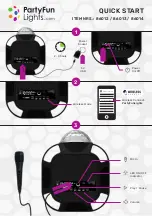
- 9 -
source; as an exception, electrodes with an acid coating are connected to the negative
pole (-).
Connect the electrode holder clamp cable to the quick connector (+) on the front panel.
Note:
In some cases, (-) polarity is recommended for the electrode holder clamp, so
check the electrode manufacturer’s instructions.
5.5.3.2 Connecting the welding current return cable
- This is connected to the piece being welded or to the metal bench supporting it, as
close as possible to the join being made.
- This cable is connected to the terminal with the symbol (-).
5.5.4 WARNINGS
- Turn the welding cable connectors right down into the quick connections , to ensure
a perfect electrical contact; otherwise the connectors themselves will overheat,
resulting in their rapid deterioration and loss of efficiency.
- The welding cables should be as short as possible.
- Do not use metal structures which are not part of the workpiece to substitute the
return cable of the welding current: this could jeopardise safety and result in poor
welding.
5.6 LOADING THE WIRE REEL (FIG. I)
WARNING! BEFORE STARTING THE OPERATIONS TO LOAD THE
WIRE MAKE SURE THE WELDING MACHINE IS SWITCHED OFF AND
DISCONNECTED FROM THE MAIN POWER SUPPLY OUTLET.
MAKE SURE THAT THE WIRE FEEDER ROLLERS, THE WIRE GUIDE HOSE AND
THE CONTACT TIP OF THE TORCH MATCH THE DIAMETER AND TYPE OF WIRE
TO BE USED AND MAKE SURE THAT THESE ARE FITTED CORRECTLY. WHEN
INSERTING AND THREADING THE WIRE DO NOT WEAR PROTECTIVE GLOVES.
- Open the reel compartment door.
- Position the wire reel on the spindle, holding the end of the wire upwards; make sure
the tab for pulling the spindle is correctly seated in its hole (1a).
- Release the pressure counter-roller/s and move it/them away from the lower roller/s
(2a).
- Make sure the puller roller is suitable for the wire being used (2b).
- Free the end of the wire and remove the distorted end with a clean cut and no burr;
turn the reel anti-clockwise and thread the end of the wire into the wire-guide infeed,
pushing it 50-100mm into the wire guide of the torch fitting (2c).
- Re-position the counter-roller/s, adjusting the pressure to an intermediate value,
and make sure that the wire is correctly positioned in the groove of the lower roller
(3).
- Use the adjustment screw located at the centre of the spindle to apply a slight
braking pressure on the spindle itself (1b).
- Remove the nozzle and contact tip (4a).
- Insert the welding machine plug in the power supply outlet, switch on the welding
machine, press the torch button and wait for the end of the wire to pass through the
whole of the wire guide hose and protrude by 10-15 cm from the front part of the
torch, release the button.
WARNING! During these operations the wire is live and subject to
mechanical stress; therefore if adequate precautions are not taken
the wire could cause hazardous electric shock, injury and striking of
electric arcs:
- Do not direct the mouthpiece of the torch towards parts of the body.
- Keep the torch away from the gas bottle.
- Re-fit the contact tip and the nozzle onto the torch (4b).
- Check that wire feed is regular; set the roller and spindle braking pressure to the
minimum possible values making sure that the wire does not slide in the groove and
when feed is halted the loops of wire are not loosened by excessive reel inertia.
- Cut the end of the wire so that 10-15 mm protrude from the nozzle.
- Close the reel compartment door.
5.7 REPLACING THE LINER IN THE TORCH (FIG. N)
Before proceeding to replace the hose, lay out the torch cable straight without any
bends.
5.7.1 Coiled hose for steel wires
1- Unscrew the nozzle and contact tip on the torch head.
2- Unscrew the hose locking nut on the central connector and remove the old hose.
3- Insert the new hose into the cable-torch duct and push it gently until it comes out
of the torch head.
4- Tighten up the hose locking nut by hand.
5- Trim off all the excess protruding hose pressing it slightly; remove it from the torch
cable again.
6- Smooth the part where the hose was cut and reinsert it into the cable-torch duct.
7- Tighten up the nut again using a spanner.
8- Reassemble the contact tip and nozzle.
5.7.2 Synthetic hose for aluminium wires
Carry out operations
1, 2, 3
as given for the steel hose (ignore operations
4, 5, 6, 7, 8
).
9- Re-tighten the contact tip for aluminium, making sure it comes into contact with the
hose.
10- At the other end of the hose (torch connector end) insert the brass nipple and the
OR ring and, keeping slight pressure on the hose, tighten the hose locking nut.
The excess part of the hose will be removed to size later on (see (13)).
Extract the capillary pipe for steel hoses from the wire feeder torch connector.
11- THE CAPILLARY PIPE IS NOT REQUIRED for aluminium hoses of diameter 1.6-
2.4mm (coloured yellow); the hose is therefore inserted into the torch connector
without it.
Cut the capillary pipe for aluminium hoses of diameter 1-1.2mm (coloured red) to
approx. 2mm shorter than the steel pipe, and insert it into the free end of the hose.
12- Insert and lock the torch into the wire feeder connector, mark the hose at 1-2mm
from the rollers, take the torch out again.
13- Cut the hose to the required size, without distorting the inlet hole.
Reassemble the torch in the wire feeder connector and assemble the gas nozzle.
6. WELDING: DESCRIPTION OF THE PROCEDURE
6.1 MIG-MAG WELDING
6.1.1 SHORT ARC TRANSFER MODE
The melting of the electrode wire and the detachment of the drop is produced by
repeated short circuits (up to 200 times per second) from the tip of the wire to the
molten pool.
Carbon and mild steels
- Suitable wire diameter:
0.6-1.2mm
- Welding current range:
40-210A
-
Arc voltage range:
14-23V
- Suitable gases:
CO
2
, mix Ar/CO
2
, Ar/CO
2
/O
2
Stainless steels
- Suitable wire diameter:
0.8-1mm
-
Welding current range:
40-160A
-
Arc voltage range:
14-20V
-
Su
itable gases:
mix Ar/O
2
, Ar/CO
2
(1-2%)
Aluminium and alloys
- Suitable wire diameter:
0.8-1.6mm
- Welding current range:
75-160A
- Arc voltage range:
16-22V
- Suitable gases:
Ar 99.9%
Generally, the contact tip should be flush with the nozzle or protrude slightly when
using the thinnest wires and lowest arc voltages; the length of free wire (stick-out) will
normally be between 5 and 12mm.
In MANUAL MODE (“PRG 0”) adjust the reactance value:
- 5%-60% with carbon steel wires of diameter 0.8-1mm.
- 50%-80% with carbon steel wires of diameter 1.2-1.6mm.
- 60%-80% with stainless steel and aluminium wires.
Application:
Welding in all positions, on thin material or for the first passage in
bevelled edges, with the advantage of limited heat transfer and highly controllable
pool.
Note:
SHORT ARC transfer for welding aluminium and alloys should be used with
great care (especially with wires of diameter >1mm) because the risk of melting
defects may arise.
6.1.1.1 ROOT MIG TRANSFER MODE
ROOT MIG is a particular type of MIG Short Arc welding technique studied to keep the
weld pool colder than the Short Arc itself. Thanks to the very low heat transfer, welding
material can be deposited and only a minimum part of the piece being processed
deforms.
ROOT MIG is therefore ideal for manually filling splits and cracks. In addition the filling
operation, with regard to TIG welding, does not need welding material and it is easier
and faster to carry out.
The ROOT MIG programs are dedicated to processing carbon steel and low-alloy
steel (see TAB. 3).
6.1.2 SPRAY ARC TRANSFER MODE
Higher voltages and currents than for ”short arc” are used here to achieve the melting
of the wire. The wire tip does not come into contact with the molten pool; an arc forms
from the tip and through it flows a stream of metallic droplets. These are produeced by
the continuous melting of the electrode wire without short-circuits involved.
Carbon and mild steels
- Suitable wire diameter:
0.8-1.6mm
-
Welding current range:
180-450A
-
Arc voltage range :
24-40V
-
Suitable gases :
mix Ar/CO
2
, Ar/CO
2
/O
2
Stainless steels
- Suitable wire diameter:
1-1.6mm
-
Welding current range:
140-390A
-
Welding voltage range :
22-32V
-
Suitable gases :
mix Ar/O
2
, Ar/CO
2
(1-2%)
Aluminium and alloys
- Suitable wire diameter:
0.8-1.6mm
-
Welding current range:
120-360A
-
weld
ing voltage range :
24-30V
-
suitable gases :
Ar 99.9%
The contact tip should generally be 5-10mm inside the nozzle, the higher the arc
voltage the further inside; the length of free wire (stick-out) should normally be
between 10 and 12mm.
In MANUAL MODE (“PRG 0”), once the wire feed rate and arc voltage parameters
have been selected correctly (i.e. with compatible values), the selected value of the
reactance is immaterial.
Application:
Horizontal welding with thicknesses of at least 3-4mm (very fluid pool);
execution rate and deposit rate are very high (high heat transfer).
6.1.3 PULSE ARC TRANSFER MODE
This is a “controlled” transfer situated in the “spray arc” transfer area (modified spray
arc) and therefore has the advantages of speedy melting and lack of projections,
extending to significantly low current values so as to satisfy many typical “short arc”
applications as well.
Every current impulse corresponds to the separation of a single drop from the wire
electrode; the phenomenon occurs with a frequency that is proportional to the wire
feed rate with the variation rule related to the type and diameter of the wire itself
(typical frequency values: 30-300Hz).
Carbon and mild steels
- Suitable wire diameter:
0.8-1.6mm
-
Welding current range:
60-360A
-
Arc voltage range :
18-32V
-
Suitable gases :
mix Ar/CO
2
, Ar/CO
2
/O
2
(Co
2
max 20%)
Stainless steels
- Suitable wire diameter:
0.8-1.2mm
-
Welding current range:
50-230A
-
Welding voltage range :
17-26V
-
Suitable gases :
mix Ar/O
2
, Ar/CO
2
(1-2%)
Aluminium and alloys
- Suitable wire diameter:
0.8-1.6mm
-
Welding current range:
40-320A
-
weld
ing voltage range :
17-28V
-
suitable gases :
Ar 99.9%
Normally the contact pipe should be 5-10mm inside the nozzle, the higher the arc
voltage, the further inside; the length of free wire (stick-out) will normally be between
10 and 12mm.
Application
: “horizontal” welding on medium-low thicknesses and on heat-sensitive
materials,
particularly suitable for welding light alloys (aluminium and its alloys)
also on thicknesses below 3mm
.
6.1.4 ADJUSTING THE WELDING PARAMETERS IN MIG-MAG
6.1.4.1 Protective gas
The gas flow rate should be:
short arc:
8-14 l/min










































